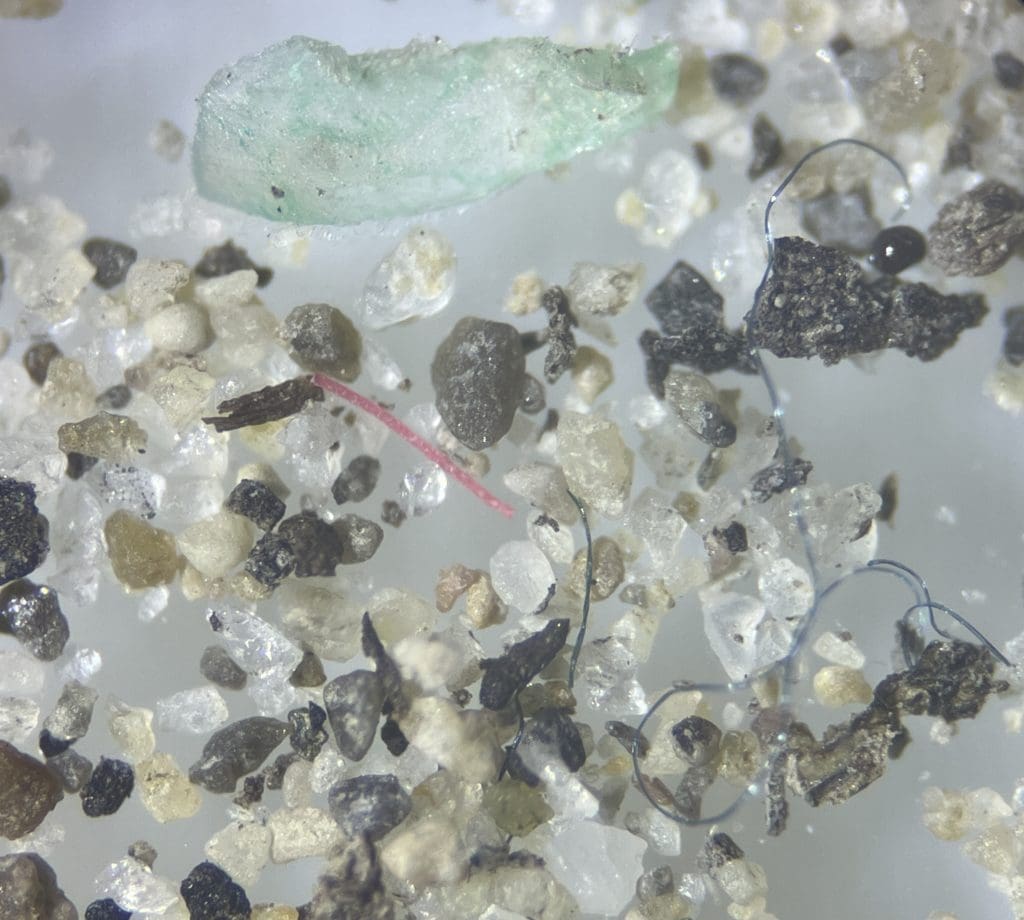Plastic pollution: the PLA'STOCK study highlights the quantity of plastic on the beaches of Lake Geneva
Thousands of plastic particles perm2
L’étude a révélé une moyenne de 7’600 particules de microplastiques (0.3 mm à 5 mm) par mètre carré, un chiffre préoccupant en comparaison avec d’autres études menées. 60 % sont notamment des fibres textiles synthétiques relâchées lors du lavage des vêtements ou par l’usure. Les 40 % restants sont issus de la fragmentation de macroplastiques. Ces derniers, visibles à l’œil nu, ont été recensés par 100 bénévoles formés et représentent une concentration moyenne de 3.4 éléments par mètre linéaire. Bien que la moitié des plages étudiées accumulent des macroplastiques, on observe une légère baisse des quantités en regard des précédents recensements. La majorité des éléments récoltés sont des plastiques fragmentés de petite taille (<2,5 cm). Ensuite, les déchets récoltés en grand nombre sont les emballages de nourriture, les mégots de cigarettes et les granulés plastiques à usage industriel.
Beaches differently impacted
Samples were taken from 25 Swiss and French beaches. Not all were affected in the same way. In Switzerland, the beaches of Les Grangettes (canton of Vaud) and Le Bouveret (canton of Valais) stand out for their high concentrations of both microplastics and macroplastics. Their proximity to the mouth of the Rhône and - in the case of Vaud - the Grand-Canal, combined with their exposure to waves, currents and winds, could explain this abundance. The beach at Port Choiseul (canton of Geneva) also stands out from the others for its high concentration of microplastics.
Scientific and civic collaboration
"Pla'stock" is an innovative study combining the efforts of the scientific and citizen communities. Volunteers played a crucial role in the collection and characterization of macroplastics, helping to raise public awareness of the pollution of waters and beaches by this waste. The microplastics were analyzed by the ASL team and students from the University of Geneva, with scientific support from CIPEL.
Environmental impact and awareness
Plastic fragmentation threatens the Lake Geneva ecosystem. The CIPEL 2021-2022 study shows significant bioaccumulation of microplastics in Lake Geneva fish. These particles, which carry pollutants such as heavy metals and persistent organic compounds, increase the toxicity of plastics for aquatic organisms.
The results highlight the extent of this pollution on the shores of Lake Geneva, the largest lake in Western Europe. Measures need to be taken to reduce the input of plastics into the lake, particularly via tributaries and rainwater. Raising awareness among the public and local authorities is essential for concrete, effective action.
Towards sustainable solutions
The European Union has introduced proactive measures, including the mandatory installation of prefilters on washing machines by 2025, aimed at reducing this major source of pollution. In Switzerland, the Federal Council and National Council rejected a motion tabled in the Swiss Parliament in 2019 to make prefilters mandatory on washing machines, citing high costs for consumers and uncertain environmental benefits.
Despite this rejection, voluntary initiatives remain crucial to reducing microfiber pollution and protecting the biodiversity of Lake Geneva. The use of anti-microfiber washing bags, for example, captures some of the fibers released during washing. Choosing better-quality, durable textiles that release fewer fibers is also possible. What's more, adopting good washing practices, such as washing at low temperatures and reducing the frequency of washes, helps to limit wear and tear and the release of microfibers.
📸 Photo credit: ASL









